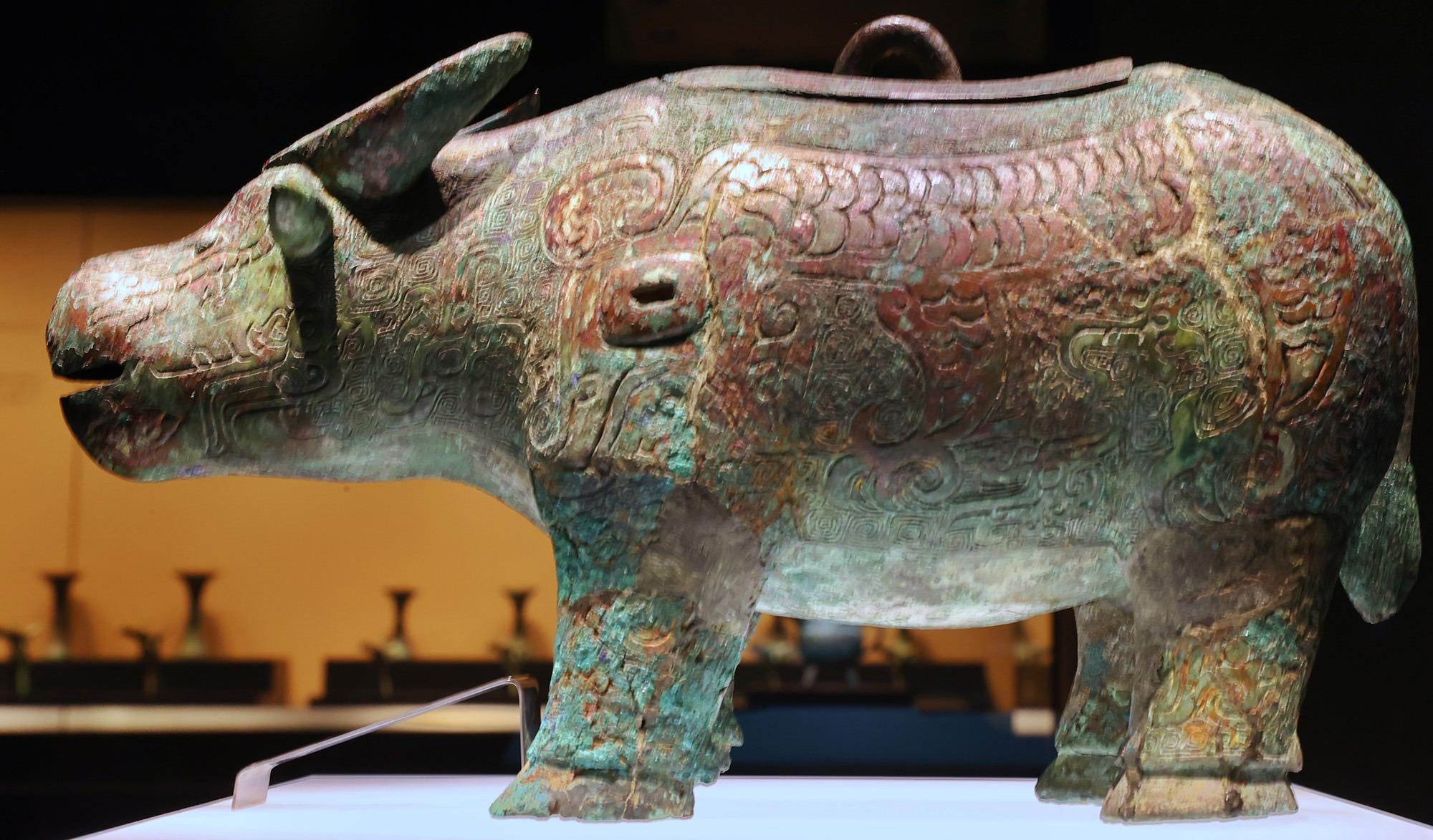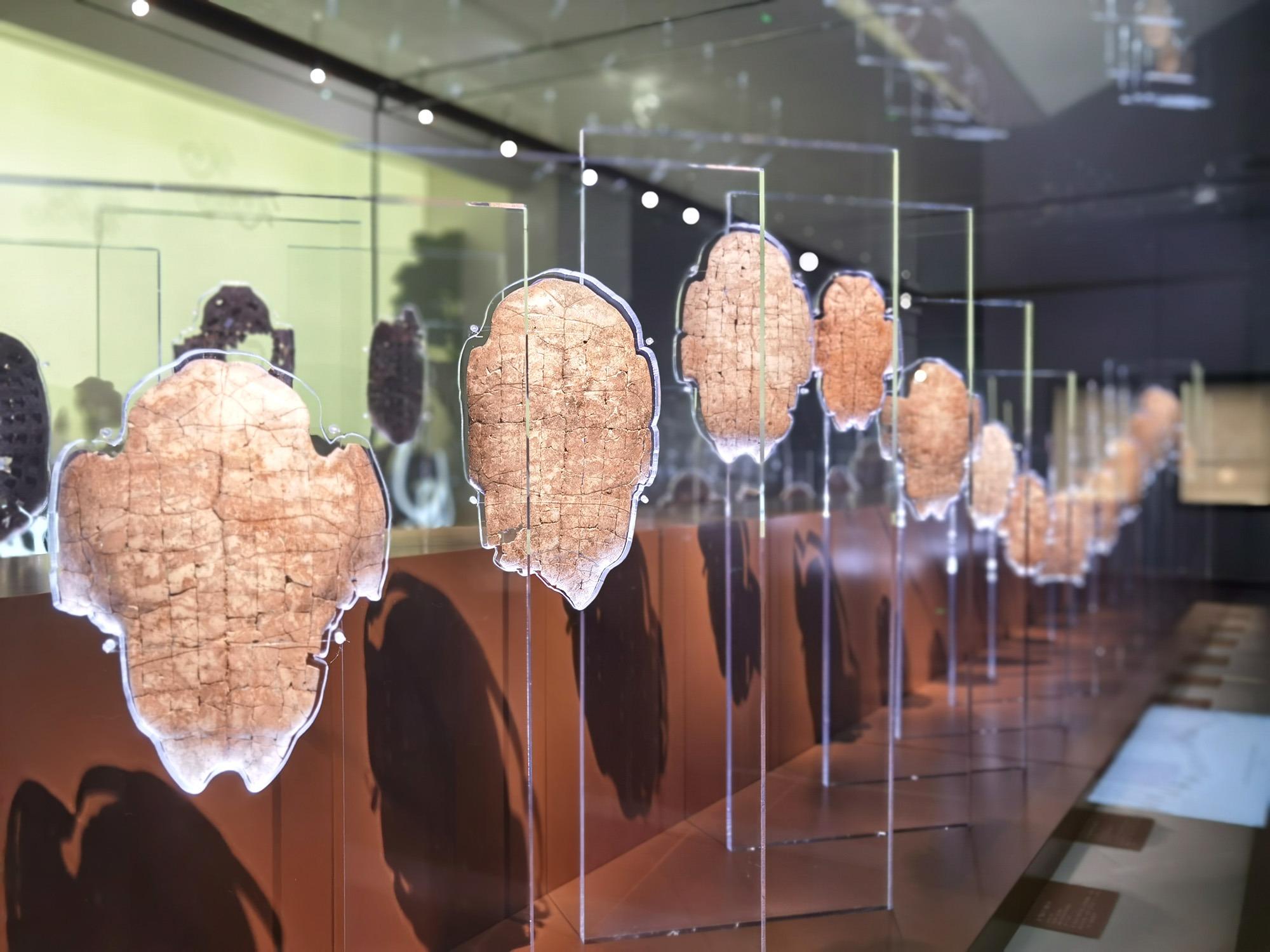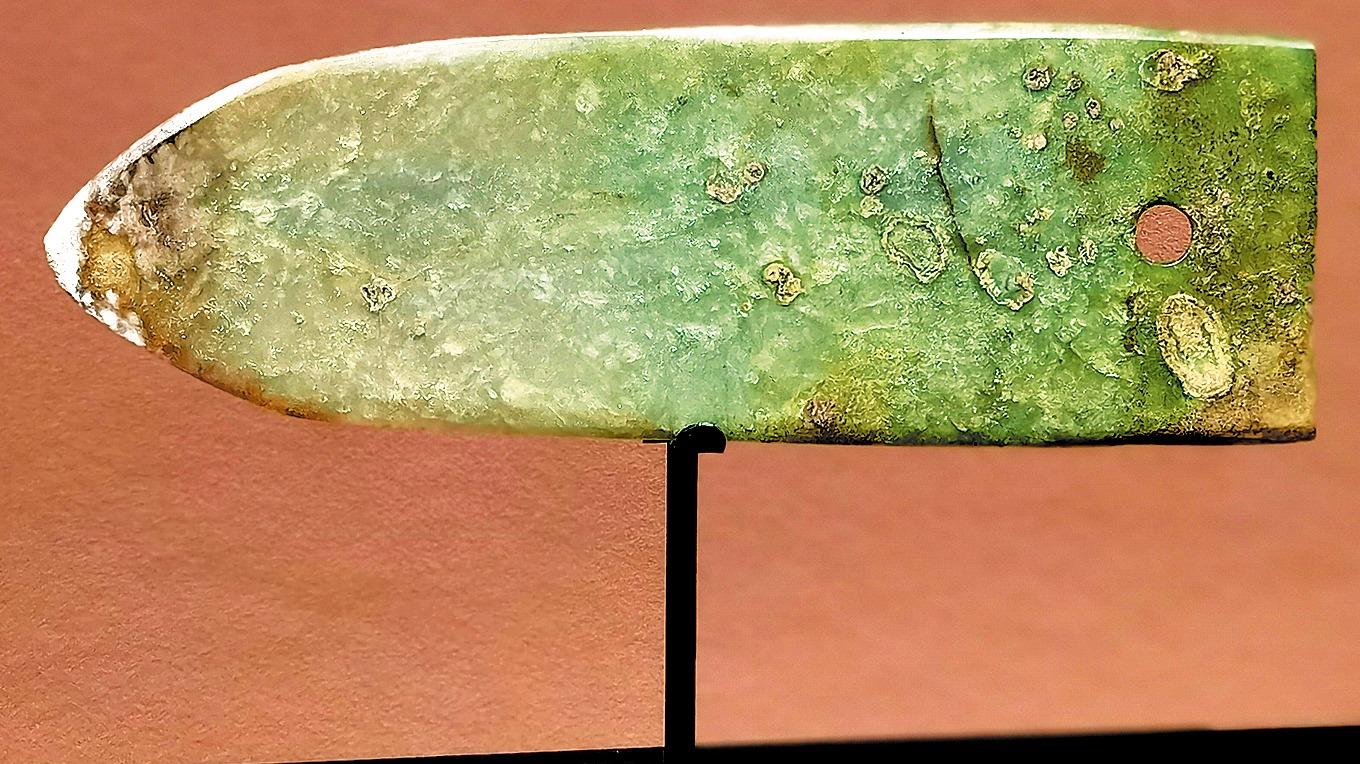Museum stands as testament to the Shang Dynasty's legacy, Wang Kaihao reports in Anyang, Henan province.
 An owl-shaped bronze vessel known as you, which was unearthed from Yinxu Ruins in 1999. (JIANG DONG / CHINA DAILY)
An owl-shaped bronze vessel known as you, which was unearthed from Yinxu Ruins in 1999. (JIANG DONG / CHINA DAILY)
When Di Xin desperately witnessed the defeat of his mighty army to the Zhou people, the last king of the Shang Dynasty (c. 16th — 11th century BC), realizing his fate was sealed, set himself ablaze. His followers surrendered, marking the end of a prosperous kingship.
The people of Shang, also known as the Yin, once proudly referred their capital city in present-day Anyang, Henan province, as Dayishang ("the grand metropolis of Shang"). However, after the upheaval that ended Di Xin's reign, the grand metropolis faded into legend.
In Shiji (Records of the Grand Historian), the monumental book on Chinese history that was compiled about a millennium after the fall of Shang, the place was called Yinxu ("ruins of Yin").
READ MORE: New museum to display best of Shang civilization
But time blurred a country's collective memory. Hidden beneath the earth, the whereabouts of Yinxu became a mystery. For a long time, if people wanted to glimpse the 500-year-long Shang era, accessible materials were limited: there was just the brief, 2,868-character account on the Shang Dynasty that appeared in Shiji, of which a large part focuses on Di Xin, and a few other fragmented records written long after Shang collapsed.
Amid the aftermath of continuous defeats by invading foreign powers and a deep social crisis in the early 20th century, Chinese people's self-confidence was largely shaken. Many scholars then doubted the credibility of their own past, and tended to believe Shang era only existed in ancient ancestors' imagination rather than actual history.
Fortunately, in 1928, the epoch-defining discovery of the Yinxu Ruins, which spreads across over 30 square kilometers in Anyang, changed everything.
 An ox-shaped bronze ritual vessel known as zun, whose function remains unknown, unearthed from Shang general Ya Zhang's tomb. (JIANG DONG / CHINA DAILY)
An ox-shaped bronze ritual vessel known as zun, whose function remains unknown, unearthed from Shang general Ya Zhang's tomb. (JIANG DONG / CHINA DAILY)
Since then, it has become the longest-studied ancient capital city ruins site in China, and is also honored as one of the cradles of modern Chinese archaeology.
In the past century, the site has yielded fruitful discoveries including ritual bronzes, jades, and 3,300-year-old oracle bones — the inscribed animal bones and turtle shells used for fortunetelling and recording events. The inscriptions reveal the oldest-known mature writing system of Chinese characters.
No wonder why Li Boqian, an 87-year-old veteran archaeologist from Peking University, commented: "In terms of archaeology, no other site in China is more important than Yinxu."
Last week, the newly built Yinxu Museum at the site began to receive visitors. Its appearance resembles that of some of the bronze relics within, complete with patina. Only one word in three Chinese characters, written in oracle bone scripts, hang above its entrance: Dayishang.
It offers a long-awaited journey through time: around 4,000 exhibits usher people back to that grand metropolis of old.
On its opening day, over 5,000 visitors were welcomed into what is China's first comprehensive archaeology museum focused on providing a panoramic view of the Shang civilization. With 22,000 sq m of galleries, visitors can admire the exquisite Shang relics and revel in their beauty.
However, behind the mesmerizing luster, there is the devotion of archaeologists to trace the path of the civilizations this land is inherited from.
According to Chen Xingcan, head of the Institute of Archaeology with the Chinese Academy of Social Sciences, also director of the new museum, over 90 percent of the exhibits were excavated by generations of the institute's researchers after the founding of New China in 1949.
"The findings not only verify what is recorded in history, but also greatly expand our knowledge of what the life of the Shang people looked like," he says. "Yinxu was our starting point to explore early stage Chinese civilizations. The new museum showcases the fruits of our academic endeavors to the public and will provide great impetus for our future studies."
 A bronze hand, whose function remains unknown, unearthed from Shang general Ya Zhang's tomb. (JIANG DONG / CHINA DAILY)
A bronze hand, whose function remains unknown, unearthed from Shang general Ya Zhang's tomb. (JIANG DONG / CHINA DAILY)
A wealth of knowledge
The Shang Dynasty was ruled by 31 kings across 17 generations, according to Shiji. Over that time, five different cities served as its capital, of which Yinxu was the last and longest-used. It enjoyed the ultimate status for nearly three centuries.
In Shijing (Book of Songs), an ancient Chinese collection of poetry from the 11th to 6th century BC, one stanza reads:
"Heaven sent a Swallow down, to give birth to the Sire.
Of Shang who wore the crown, of the land of Yin entire."
Archaeological finds at Yinxu may help bring those romantic notions to life. Royal palaces, ancestral temples, urban residences, kings' mausoleums, plebeians' tombs, handicraft workshops and other discoveries join together to present a panorama of city life.
Erected just across the river from the palace and temple area, the new museum has numerous stories to share via its exhibits.
Abundant ritual bronze ware, many items of which are showcased in whole sets, portray a rich spiritual life. Their complicated decorative patterns — taotie (a mythological creature), dragons, phoenixes, cicadas, and so on, represent a mix of totems and artistic styles from across various regions in China.
The exhibited 23 burial chariots and horse skeletons also reveal the might of the Shang kings. Integrating advanced techniques such as fine woodwork, metal casting, carving and lacquering, these chariots, the earliest examples of their kind in China, also demonstrate the remarkable craftsmanship of the time.
 A bronze vessel known as jia unearthed from Ya Zhang's tomb. (WANG KAIHAO / CHINA DAILY)
A bronze vessel known as jia unearthed from Ya Zhang's tomb. (WANG KAIHAO / CHINA DAILY)
At its zenith, the rule of the Shang spread widely across North and Central China, reaching to the Yangtze River, East China Sea, as well as the Yanshan and Longshan mountains, all hundreds of kilometers away from Anyang.
"Shang created a splendid Bronze Age civilization through continuous innovation," Li Xiaoyang, director of Anyang Cultural Heritage Administration, says. "It absorbed diverse cultural influences from surrounding regions: pottery from the east, gold artifacts from the west, metallurgy from the south, and chariots from the north. All of these cultural elements were constantly repurposed to enrich the characteristics of Shang civilization."
Many of the exhibited bronze items are also inscribed with words of people paying homage to their families.
"Ancient people once focused more on sacrificial rituals for Heaven," Li Xiaoyang adds. "But, during Yinxu's era, they tended to more intensively worship their ancestors, as revealed by these ritual bronze items."
With the king as its core and clans as its units, Shang civilization established a solid structure and, thus, laid a foundation for the social order of early-stage China — the integration of family and state — he explains.
Shang people may have devoted the precious and heavy bronze vessels to their long passed ancestors, but, like us today, they also sought a comfortable life. Cheaper pottery seems a better choice. From pipelines and wine cups, to "towels" for bathing, a world made of ceramic unveils a host of kaleidoscopic Shang stories in the galleries.
Within the museum is a gallery exclusively dedicated to Ya Zhang, an aristocrat and a general, which houses some highlighted exhibits, like an ox-shaped ritual vessel called zun.
Indeed, the 577 burial objects from this 35-year-old man's tomb, including bronzes, jades and bone artifacts, as well as hundreds of arrowheads, gold fillets and seashells (used as money), demonstrate his wealth and power.
"Technology can also help us to study how he lived, survived several injuries, and died in battle," He Yuling, the exhibition curator and a researcher specializing in the Shang era at the Institute of Archaeology, says. "Seeing Ya Zhang's whole life exhibited here, his bravery may resonate with today's visitors."
 A stone cup carved with decorative patterns of the mythological animal kuilong. (JIANG DONG / CHINA DAILY)
A stone cup carved with decorative patterns of the mythological animal kuilong. (JIANG DONG / CHINA DAILY)
A prince's diaries
For Shang people, divination through oracle bones was an essential part of life, especially before making any major decision or preparing to launch an endeavor. Questions were carved onto the bones, and intense heat was applied to create cracks, which would then be interpreted by diviners or oracles.
The characters etched upon these oracle bones bear the lineage of Chinese civilization. Their evolution would finally form the basis of the written Chinese used by people today.
The most recent major discovery of oracle bones was made at the site in 1991. On that occasion, archaeologists excavated 1,583 animal bones and turtle shells, of which 689 pieces were inscribed. They leave about 2,250 divination records as credible references to Shang society during the reign of Wu Ding, a famous Shang king who ruled around 3,300 years ago.
Apparently, someone with the honorific title Zi had many questions about everyday life, ranging from inquiries about music, dance, archery and hunting to dining and the weather.
One gallery at Yinxu Museum is dedicated to exhibiting this key group of records, which were later found to belong to Wu Ding's son.
"These inscriptions provide a vivid record of Zi's daily activities," says Yu Chenglong, an archaeologist with the Anyang Cultural Heritage Administration who curates the exhibition. "We're reading a prince's diary."
Feeling a bit under the weather, the young prince referred to divination as to whether he should go to school, as one oracle bone reveals.
"It's like a doctor's note, as the noble schools back then had rigid regulations," Yu explains.
Another exhibit shows that Wu Ding once went to school to see Zi's dancing class.
"It's really emotional, like today's parents who go to watch their kids' performances," the curator says." Wu Ding was a king of blood and iron, but such a man known for heroism on battlefield also had his soft side.
"Words carved on bones look cold and stiff," Yu continues. "However, after we wipe off the dust of time, we can feel the warmth of a Shang family. That's the charm of history."
He adds that the exhibits also offer crucial clues to the kinship system, social structures and etiquette of Shang people in general.
 The Yinxu Museum, resembling a bronze ware, with the word "Dayishang "above its entrance. (PROVIDED TO CHINA DAILY)
The Yinxu Museum, resembling a bronze ware, with the word "Dayishang "above its entrance. (PROVIDED TO CHINA DAILY)
An endless journey
Yinxu may be larger than people usually think. The archaeological research of recent years has continuously added to the map of Dayishang and beyond what were once considered to be its boundaries.
According to Niu Shishan, a researcher with the CASS Institute of Archaeology in charge of excavations at Yinxu Ruins, the discovery of urban road networks and ditches made since the turn of the century has, so far, pushed those "boundaries" outward by several kilometers on all four sides of the city.
"And, the last decade has also borne witness to key findings within the city," he adds. "Over 3,000 sacrificial pits and burial pits have been found in the royal mausoleum. A garden with an artificial lake, which is over 50,000 sq m, was found to the west of the palace area."
New findings at the Yinxu royal mausoleum were listed among China's Top 10 Archaeological Discoveries of 2022 by China Cultural Relic News and the Archaeological Society of China.
The ruins of a super-sized bronze casting workshop, spreading over 70 hectares about 9 km to the northeast of Yinxu, are thought to be those of the world's largest facility of its kind during its time.
"Archaeological evidence shows that, in its time, Yinxu was the largest city in East Asia," Niu says. "This top-tier metropolis was also surrounded by smaller second- and third-tier satellite cities."
Archaeologists have excavated about five percent of the total area within the Yinxu Ruins site. Though this percentage is higher than most large-scale ancient city ruins in China due to the length of time spent researching the site, Chen, the museum director, notes that many unsolved puzzles still exist.
"As the exhibits indicate, a lot of excavated items from Yinxu were previously unseen," he explains. "We don't know what they're used for. Numerous gaps exist in our understanding of the society, politics, and culture of Shang. Some evidence may still be buried underground, and some may have disappeared forever.
"For people today, it's impossible to get a full picture of the Shang Dynasty, but our endless journey toward that goal will continue for generations to come," Chen says.
The archaeologist He expects the Yinxu Museum will provide a new technical facility for detailed archaeological studies under laboratory conditions.
"Visitors can also view our ongoing studies in the near future," He says, referring to a locked area of the museum. "It's the duty of the archaeologists to brief the public on our latest findings."
 Displayed oracle bones that were unearthed in 1991 from the Yinxu Ruins cast light on a Shang prince's everyday life. (WANG KAIHAO / CHINA DAILY)
Displayed oracle bones that were unearthed in 1991 from the Yinxu Ruins cast light on a Shang prince's everyday life. (WANG KAIHAO / CHINA DAILY)
A lasting inspiration
To save his waning rule, the last Shang king Di Xin launched a series of radical reforms. They ignited conflicts between central kingship and local nobles, which also contributed to his failure against the Zhou people, who subsequently established the Western Zhou Dynasty (c. 11th century — 771 BC).
However, Zhou kings still reserved noble titles and fiefdoms for Shang loyalists to appease their anger. Craftsmanship, cultivation techniques, ritual systems, and various aspects of Shang civilization thus continue to influence China throughout history, as He notes.
Consequently, more than 3,000 years after the fall of the Shang Dynasty, its shadows still linger.
"Its prosperous cities, complete ritual culture, bronze craftsmanship, advanced writing system, and scientific developments contributed to the brilliant eras of early China that followed," Chen says. "In the process of tracing the past, we can better understand the present, and acquire the wisdom to face the future."
And such legacies may not only benefit China.
In the early 20th century when Chinese society was unstable, many scattered Shang relics and fragments of oracle bones were taken overseas before the official archaeological excavations were organized. They are now housed in over 60institutions around the world, mainly in the United States, the United Kingdom, France, Germany, Canada and Japan.
Though it remains an area of huge regret for the Chinese people, these relics have also been collected and studied by scholars around the world, giving Yinxu global significance.
"Countless foreign scholars have dedicated themselves to Shang studies and explored the profound meanings of the Shang relics, leaving behind a wealth of insight," Chen explains.
The Yinxu Ruins were inscribed as a UNESCO World Heritage Site in 2006. In 2017, the oracle bone inscriptions were listed in the UNESCO Memory of the World Register program.
"The material remains discovered at Yinxu provide tangible evidence of the early history of the Chinese writing and language, ancient beliefs, social systems, and major historical events, which are considered of outstanding universal significance," UNESCO states.
 A ceremonial jade item known as gui on display in the Yinxu Museum. (WANG KAIHAO / CHINA DAILY)
A ceremonial jade item known as gui on display in the Yinxu Museum. (WANG KAIHAO / CHINA DAILY)
In spite of its unique characteristics, Shang civilization also demonstrates similarities with other ancient civilizations of its time, as an exhibition at the museum explains.
For example, the Kassite people living in Mesopotamia also had traditions involving burial chariots, building shrines and ideographic writing. India, during the early Vedic period, revealed similar settlements based on agriculture.
Ancient Egypt echoes the light of Shang civilization with its extraordinary understanding of astronomy, urban planning and construction, as pharaoh Ramses II and king Wu Ding were contemporaries, ruling their respective lands around the same era. Documentation found in Mycenaean Greece also tells of its tradition of paying tribute in bronze.
Chen therefore expects the new museum at Yinxu to be a hub, promoting international academic cooperation on studies of the Shang to broaden understanding of civilizations elsewhere, as well as exchanges of cultural heritage conservation.
ALSO READ: The bone collector
Many renowned institutions around the world, including the British Museum, the Metropolitan Museum of Art, the Freer Gallery of Art, the University of British Columbia, the University of Chicago, among others, have already contributed their resources for construction of the new museum.
"Shang is a witness to the diversity of human civilization," He says. "We also expect to one day organize a large-scale, comprehensive exhibition on Shang featuring collections of exhibits from both home and abroad."
An international database will also be established within the Yinxu Museum to facilitate digitized "returning" and studies of oracle bones that were scattered across the world.
"At the beginning of excavations at Yinxu almost a century ago, Chinese archaeologists expected to set up a large museum on the site to preserve and keep whatever was unearthed at the site in China," Chen says, emotionally. "The dream has lasted for generations, and, finally, it now comes true."
Contact the writer at wangkaihao@chinadaily.com.cn


